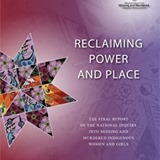 Chapter 6 of the MMIWG Inquiry Report defines health as a human right and examines how the four pathways of colonial violence impacted the health of Indigenous people. When the right health is in jeopardy, so is safety.
Chapter 6 of the MMIWG Inquiry Report defines health as a human right and examines how the four pathways of colonial violence impacted the health of Indigenous people. When the right health is in jeopardy, so is safety.
The first pathway of violence is historical trauma, including multigenerational and intergenerational. The removal of ancestors from their land took away a place of peace, belonging and safety that all children need to become healthy adults. Severity of violence can lead to additional health problems and injuries including isolation, addiction, self-harm and suicide.
Furthermore, the best single predictor of whether or not a child will be diagnosed with mental illness as an adult is whether or not they experienced violence as a child. The Opioid crisis is a Canada-wide problem with First Nations people more likely to die from overdose. Solutions include harm-reduction interventions and culturally appropriate services as well as the need to address structural and institutional inequalities such as socio-economic factors, poverty, housing, addictions, and mental health supports for trauma, pain and suffering.
The second pathway of violence is social and economic marginalization. Employment, education, housing, income, food, and sustainable resources shape the health of Indigenous people, as do their encounters with the Canadian health care system. Marginalization creates additional barriers that maintain rather than address inequalities.
Fifteen findings include similar yet distinct impact on gender diverse peoples in terms of discrimination, marginalization, and harassment. Moving to find community safety is often fraught with challenges. Youth face particular barriers within child welfare systems.
The third pathway of violence is lack of will and insufficient institutional responses. First Nations cultures see a strong connection between mental wellness and strong physical, spiritual, and emotional health. This is built on a connection to language, land, creation, ancestry, the support of a caring family and environment, and an interconnectedness enriched by hope, belonging, purpose and meaning.
“Colonialism was written in the genetic code of the mental health industry” observed expert witness Allan Wade. Messages of deficiency rather than proficiency illustrated power, hierarchy, racism, and the colonial code of relationship.
Fifteen more findings focus on issues specific to the Inuit and how failure to protect their rights weakened their culture and contributed to high rates of violence. Kinship ties are central to safety and will-being and these have been compromised in many ways.
The fourth pathway to violence is patriarchy that ignores the agency and expertise of Indigenous women. Understanding the role of culture, ceremony, land, and language can be transformative in promoting both individual well-being and collective healing. The right to health engages with standards of living and well-being that are connected to other rights such as economic, social, political, and global connections. Family is considered a fundamental unit of society with rights to adequate standard of living, protection from violence, preventative health care, and education.
Unfortunately, trauma has been normalized for Indigenous people. Ten final findings include that unresolved trauma is a root cause of high rates of chronic health problems, interpersonal violence, and substance abuse. Canada has failed to ensure that the health and wellness needs of Indigenous women have been met. Health and wellness services are most effective when designed by the people they are supposed to serve, grounded in practices, world views, culture, language, and values. First Nations solutions and strengths are undervalued by the current system.

